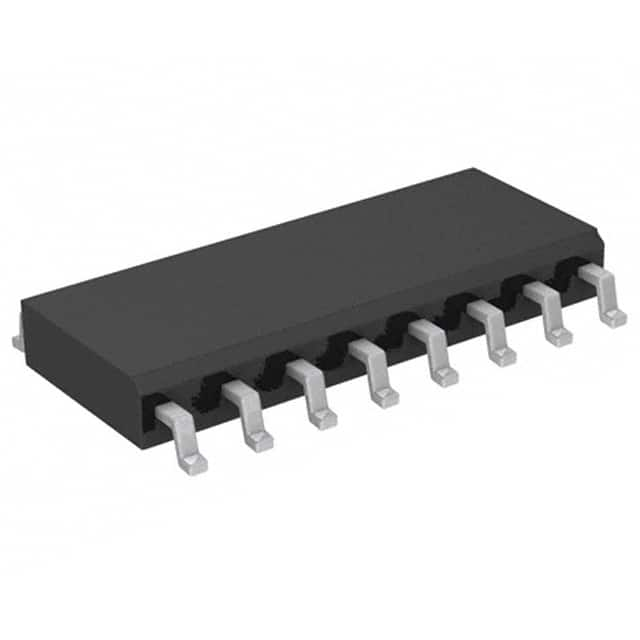Lihat spesifikasi untuk detail produk.

74HC366D,652
Product Overview
Category
The 74HC366D,652 belongs to the category of integrated circuits (ICs).
Use
This IC is commonly used for signal buffering and line driving applications.
Characteristics
- High-speed operation
- Wide operating voltage range
- Low power consumption
- Schmitt-trigger inputs for noise immunity
- Balanced propagation delays
- Symmetrical output impedance
Package
The 74HC366D,652 is available in a small outline package (SO) with 14 pins.
Essence
The essence of this product lies in its ability to provide reliable signal buffering and line driving capabilities in various electronic circuits.
Packaging/Quantity
The 74HC366D,652 is typically packaged in reels or tubes, with a quantity of 2500 units per reel/tube.
Specifications
- Supply Voltage Range: 2V to 6V
- Input Voltage Range: 0V to VCC
- Output Voltage Range: 0V to VCC
- Operating Temperature Range: -40°C to +125°C
- Input Capacitance: 3.5pF
- Output Capacitance: 6pF
- Propagation Delay: 10ns (typical)
Detailed Pin Configuration
- A1 - Input A1
- B1 - Input B1
- Y1 - Output Y1
- A2 - Input A2
- B2 - Input B2
- Y2 - Output Y2
- GND - Ground
- Y3 - Output Y3
- B3 - Input B3
- A3 - Input A3
- Y4 - Output Y4
- OE - Output Enable
- VCC - Power Supply
- NC - No Connection
Functional Features
- Quad 3-state buffer with Schmitt-trigger inputs
- Independent enable control for each buffer
- High-speed operation allows for efficient signal buffering
- Wide operating voltage range enables compatibility with various systems
- Low power consumption ensures energy efficiency
- Balanced propagation delays ensure accurate signal transmission
- Schmitt-trigger inputs provide noise immunity, enhancing signal integrity
Advantages and Disadvantages
Advantages
- High-speed operation
- Wide operating voltage range
- Low power consumption
- Noise immunity due to Schmitt-trigger inputs
- Balanced propagation delays
Disadvantages
- Limited number of buffers (4 in total)
- May require additional components for complex applications
Working Principles
The 74HC366D,652 operates as a quad 3-state buffer with Schmitt-trigger inputs. It receives input signals from the A1, A2, A3, and B1, B2, B3 pins and provides buffered outputs at the Y1, Y2, Y3, and Y4 pins. The OE pin controls the output enable function, allowing the user to activate or deactivate the buffer outputs.
When the OE pin is low, the outputs are enabled and mirror the input signals. Conversely, when the OE pin is high, the outputs are disabled and enter a high-impedance state, effectively disconnecting them from the circuit.
The Schmitt-trigger inputs ensure noise immunity by providing hysteresis, which helps to filter out unwanted fluctuations in the input signals.
Detailed Application Field Plans
The 74HC366D,652 finds application in various electronic systems where signal buffering and line driving are required. Some specific application fields include:
Microcontroller-based systems: The IC can be used to interface microcontrollers with external devices, ensuring reliable signal transmission.
Communication systems: It can be employed in communication circuits to buffer and drive signals between different modules or components.
Industrial automation: The IC can be utilized in industrial automation systems for signal conditioning and amplification purposes.
Automotive electronics: It finds application in automotive electronics, such as in-car entertainment systems, where it helps in signal buffering and driving.
Detailed and Complete Alternative Models
- SN74HC366D - Similar quad 3-state buffer with Schmitt-trigger inputs, offered by Texas Instruments.
- CD74HC366E - Quad 3-state buffer with Schmitt-trigger inputs, available from Texas Instruments.
- MC74HC366N - Equivalent quad 3-state buffer with Schmitt-trigger inputs, manufactured by ON Semiconductor.
These alternative models offer similar functionality and can be used as substitutes for the 74HC366D,652 based on specific requirements and availability.
In conclusion, the 74HC366D,652 is a versatile integrated circuit that provides reliable signal buffering and line driving capabilities. Its high-speed operation, wide operating voltage range, and low power consumption make it suitable for various applications in different fields.
Sebutkan 10 pertanyaan dan jawaban umum terkait penerapan 74HC366D,652 dalam solusi teknis
Sure! Here are 10 common questions and answers related to the application of 74HC366D,652 in technical solutions:
Q: What is the function of the 74HC366D,652? A: The 74HC366D,652 is a hex buffer with open-drain outputs. It can be used to amplify and buffer digital signals.
Q: What is the maximum voltage that can be applied to the inputs of the 74HC366D,652? A: The maximum voltage that can be applied to the inputs is VCC + 0.5V.
Q: What is the maximum output current of the 74HC366D,652? A: The maximum output current is 25mA per output.
Q: Can the 74HC366D,652 be used with both TTL and CMOS logic levels? A: Yes, the 74HC366D,652 is compatible with both TTL and CMOS logic levels.
Q: How many open-drain outputs does the 74HC366D,652 have? A: The 74HC366D,652 has six open-drain outputs.
Q: What is the typical propagation delay of the 74HC366D,652? A: The typical propagation delay is 11ns.
Q: Can the 74HC366D,652 be used in high-speed applications? A: Yes, the 74HC366D,652 can be used in high-speed applications as it has a maximum frequency rating of 80MHz.
Q: Does the 74HC366D,652 require external pull-up resistors for the open-drain outputs? A: Yes, external pull-up resistors are required for the open-drain outputs.
Q: What is the operating temperature range of the 74HC366D,652? A: The operating temperature range is -40°C to +125°C.
Q: Can the 74HC366D,652 be used in automotive applications? A: Yes, the 74HC366D,652 is qualified for automotive applications and meets the requirements of the AEC-Q100 standard.
Please note that these answers are based on general information about the 74HC366D,652 and may vary depending on specific datasheet specifications and application requirements.

